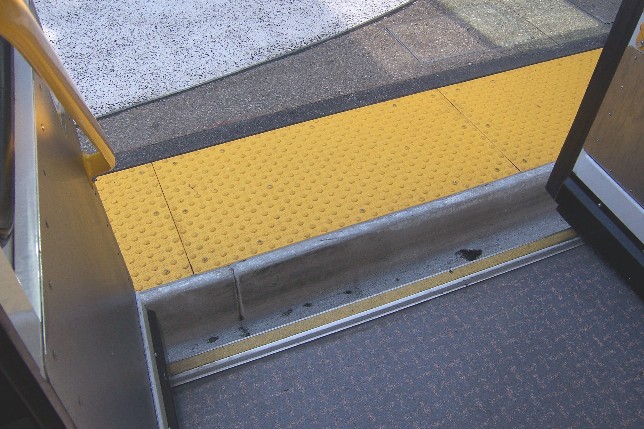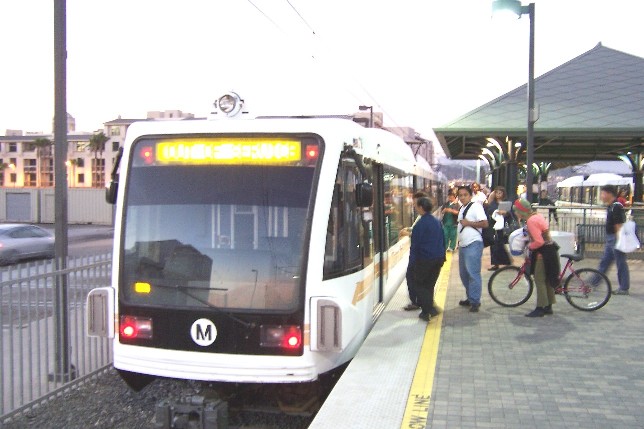Part 5 – Accessibility for Mobility-Challenged
This continues our photo-report examining Los Angeles's new "Orange Line" busway, widely regarded as perhaps the premier recent example of state-of-the-art "Bus Rapid Transit" ("BRT") – and the broad range of claims that this type of bus deployment is "rapid transit on rubber tires" and "just like rail transit, but cheaper". In this section, we turn to issues of accessibility for passengers with mobility challenges and compliance with the Americans with Disabilities Act (ADA) – including a comparison with light rail transit (LRT).
"BRT" promoters have continuously tried to inculcate the impression that "BRT" buses provide multi-door level boarding, "just like rail transit". In the case of the "Orange Line", promoters originally emphasized that lowfloor vehicles and platforms similar to LRT would be provided – basically, a kind of "wink and nudge" suggestion that boarding would be similar to that on the region's metro and LRT trains.
Anti-rail transit enthusiasts of motor vehicle transportation have generally rallied to support "BRT" schemes and have fostered the notion that boarding characteristics are basically identical to those of rail systems. Tom Rubin, for example (a former Controller-Treasurer for the Southern California Rapid Transit District and a well-known national critic of rail projects), in a 2000 document co-authored with James E. Moore ii and Shin Lee, argued that the Los Angeles transit agency should replace its rail program with the construction of busways – even advocating that "Existing rail rights of way can be retorfitted for use as exclusive busways." Curiously, hired by opponents of the "Orange Line" busway, Rubin opposed that project; nevertheless, he clearly maintains that it is a clear example of "BRT". In an August 2006 commentary posted on Wendell Cox's Transport Policy online dicussion list, Rubin asserted:
The "narrow" definition of BRT is, pretty much, the Orange Line, with a dedicated guideway, pre-paid boarding through all doors, signal preference..., level boarding, and certain other features....
Despite his own reservations about the "Orange Line" project, Rubin seems to regard it as superior to light rail. Challenging arguments that LRT would be preferable in the corridor, for example, Rubin dismissed the notion that LRT would provide faster boarding, again raising the "level boarding" claim: "Given similar width doors and pre-paid level boarding for both LRT and the Orange Line, exactly how is [it] that LRT boards faster than BRT...?"
Transport planners and local transit agencies have also promulgated the notion that "BRT" buses and station platforms offer full level boarding. Describing San Bernardino's proposal for "BRT", called SbX, the San Bernardino Sun ("Speedy buses in the works?", 2005/10/17) relayed official claims that
Stops on the sbX system would resemble train stations, where platforms would be even with the low-floor buses, so getting on the bus would resemble boarding a train and would be easier for passengers in wheelchairs.
The following photos attempt to illustrate just how much the "Orange Line" busway stations supposedly "resemble train stations, where platforms would be even with the low-floor buses, so getting on the bus would resemble boarding a train and would be easier for passengers in wheelchairs."
Los Angeles "Orange Line" Busway – Gap between bus floor and platform

This photo illustrates the huge gap between bus floor and platform – amounting to perhaps six inches horizontally and even more vertically. The photo is taken from inside the bus, with door open. The lower, very narrow, dull-yellow strip marks the edge of the bus floor. The wide, brighter yellow strip, with texturing (for visually impaired passengers and others), marks the edge of the station platform. Down between the two can be seen the pavement of the busway itself (with drippings, etc.).
Visible in this photo is the enormous horizontal gap between the bus floor and
the platform – about 5-6" – but the vertical gap is hard to see because of the angle.
However, this vertical gap is obvious in the second photo (described below).
[Photo: L. Henry]
Los Angeles "Orange Line" Busway (North Hollywood) – Deboarding passenger with stroller

A "BRT" bus unloads passengers at North Hollywood.
This photo shows a passenger deboarding with a stroller from the third (rearmost) door of the bus.
in this case, clearly visible is the vast vertical gap – in the range of 8-9 inches – between the bus floor and the station platform.
For the record, the front (narrow) door of the bus does have a flipover ramp to bridge from bus floor
to platform ... but that is hardly "level boarding" equivalent to that in a "train station", either in LA's Red Line metro or light rail transit systems.
[Photo: Dave Dobbs]
Los Angeles "Orange Line" Busway – Passengers boarding "BRT" bus at Warner Center

For a system touted as having level boarding "just like light rail",
this state-of-the-art "BRT" system certainly seems to leave a lot to be desired.
Here, as passengers board an "Orange Line" bus at Warner
Center station, the sizable vertical and horizontal gaps between bus
floor and "platform" (sidewalk, actually) are clearly evident.
[Photo: L. Henry]
Los Angeles Gold Line Light Rail Transit at Union Station – True level boarding

In contrast, this view of passengers boarding a Gold Line LRT car at Union Station illustrates what "level boarding" really means.
This juxtaposition of photos of actual conditions starkly emphasizes the deceptive claim that "BRT" is "just like rail...."
[Photo: L. Henry]
Go to...